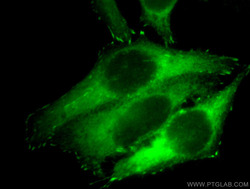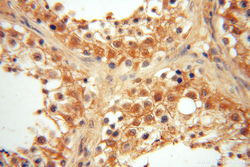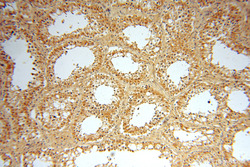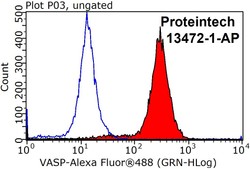Antibody data
- Antibody Data
- Antigen structure
- References [10]
- Comments [0]
- Validations
- Western blot [1]
- Immunocytochemistry [1]
- Immunohistochemistry [2]
- Flow cytometry [1]
Submit
Validation data
Reference
Comment
Report error
- Product number
- 13472-1-AP - Provider product page

- Provider
- Proteintech Group
- Proper citation
- Proteintech Cat#13472-1-AP, RRID:AB_2213418
- Product name
- VASP antibody
- Antibody type
- Polyclonal
- Description
- KD/KO validated VASP antibody (Cat. #13472-1-AP) is a rabbit polyclonal antibody that shows reactivity with human, mouse, rat and has been validated for the following applications: FC, IF, IHC, IP, WB,ELISA.
- Reactivity
- Human, Mouse, Rat
- Host
- Rabbit
- Conjugate
- Unconjugated
- Isotype
- IgG
- Vial size
- 20ul, 150ul
Submitted references Oncogenic BRAF noncanonically promotes tumor metastasis by mediating VASP phosphorylation and filopodia formation.
Quantitative Proteomic Analysis Reveals apoE4-Dependent Phosphorylation of the Actin-Regulating Protein VASP.
High-Risk HPV16 E6 Activates the cGMP/PKG Pathway Through Glycosyltransferase ST6GAL1 in Cervical Cancer Cells.
Role of vasodilator-stimulated phosphoprotein in RANKL-differentiated murine macrophage RAW264.7 cells: Modulation of NF-κB, c-Fos and NFATc1 transcription factors.
The novel ZEB1-upregulated protein PRTG induced by Helicobacter pylori infection promotes gastric carcinogenesis through the cGMP/PKG signaling pathway.
Nucleotide de novo synthesis increases breast cancer stemness and metastasis via cGMP-PKG-MAPK signaling pathway.
The Wnt/β-catenin/VASP positive feedback loop drives cell proliferation and migration in breast cancer.
Silencing lncRNA SNHG6 suppresses proliferation and invasion of breast cancer cells through miR-26a/VASP axis.
TNF‑α inhibits xenograft tumor formation by A549 lung cancer cells in nude mice via the HIF‑1α/VASP signaling pathway.
Cortical dynamics during cell motility are regulated by CRL3(KLHL21) E3 ubiquitin ligase.
Pan W, Tian Y, Zheng Q, Yang Z, Qiang Y, Zhang Z, Zhang N, Xiong J, Zhu X, Wei L, Li F
Oncogene 2023 Oct;42(43):3194-3205
Oncogene 2023 Oct;42(43):3194-3205
Quantitative Proteomic Analysis Reveals apoE4-Dependent Phosphorylation of the Actin-Regulating Protein VASP.
Cakir Z, Lord SJ, Zhou Y, Jang GM, Polacco BJ, Eckhardt M, Jimenez-Morales D, Newton BW, Orr AL, Johnson JR, da Cruz A, Mullins RD, Krogan NJ, Mahley RW, Swaney DL
Molecular & cellular proteomics : MCP 2023 May;22(5):100541
Molecular & cellular proteomics : MCP 2023 May;22(5):100541
High-Risk HPV16 E6 Activates the cGMP/PKG Pathway Through Glycosyltransferase ST6GAL1 in Cervical Cancer Cells.
Wang J, Liu G, Liu M, Cai Q, Yao C, Chen H, Song N, Yuan C, Tan D, Hu Y, Xiang Y, Xiang T
Frontiers in oncology 2021;11:716246
Frontiers in oncology 2021;11:716246
Role of vasodilator-stimulated phosphoprotein in RANKL-differentiated murine macrophage RAW264.7 cells: Modulation of NF-κB, c-Fos and NFATc1 transcription factors.
Hu H, Li C, Zhang H, Wu G, Huang Y
Experimental and therapeutic medicine 2021 May;21(5):412
Experimental and therapeutic medicine 2021 May;21(5):412
The novel ZEB1-upregulated protein PRTG induced by Helicobacter pylori infection promotes gastric carcinogenesis through the cGMP/PKG signaling pathway.
Xiang T, Yuan C, Guo X, Wang H, Cai Q, Xiang Y, Luo W, Liu G
Cell death & disease 2021 Feb 4;12(2):150
Cell death & disease 2021 Feb 4;12(2):150
Nucleotide de novo synthesis increases breast cancer stemness and metastasis via cGMP-PKG-MAPK signaling pathway.
Lv Y, Wang X, Li X, Xu G, Bai Y, Wu J, Piao Y, Shi Y, Xiang R, Wang L
PLoS biology 2020 Nov;18(11):e3000872
PLoS biology 2020 Nov;18(11):e3000872
The Wnt/β-catenin/VASP positive feedback loop drives cell proliferation and migration in breast cancer.
Li K, Zhang J, Tian Y, He Y, Xu X, Pan W, Gao Y, Chen F, Wei L
Oncogene 2020 Mar;39(11):2258-2274
Oncogene 2020 Mar;39(11):2258-2274
Silencing lncRNA SNHG6 suppresses proliferation and invasion of breast cancer cells through miR-26a/VASP axis.
Li K, Ma YB, Tian YH, Xu XL, Gao Y, He YQ, Pan WT, Zhang JW, He CJ, Wei L
Pathology, research and practice 2019 Oct;215(10):152575
Pathology, research and practice 2019 Oct;215(10):152575
TNF‑α inhibits xenograft tumor formation by A549 lung cancer cells in nude mice via the HIF‑1α/VASP signaling pathway.
Liu W, Chen X, He Y, Tian Y, Xu L, Ma Y, Hu P, Su K, Luo Z, Wei L, Zhang J
Oncology reports 2019 Apr;41(4):2418-2430
Oncology reports 2019 Apr;41(4):2418-2430
Cortical dynamics during cell motility are regulated by CRL3(KLHL21) E3 ubiquitin ligase.
Courtheoux T, Enchev RI, Lampert F, Gerez J, Beck J, Picotti P, Sumara I, Peter M
Nature communications 2016 Sep 19;7:12810
Nature communications 2016 Sep 19;7:12810
No comments: Submit comment
Supportive validation
- Submitted by
- Proteintech Group (provider)
- Main image

- Experimental details
- A431 cells were subjected to SDS PAGE followed by western blot with 13472-1-AP(VASP antibody) at dilution of 1:1000
- Sample type
- cell line
Supportive validation
- Submitted by
- Proteintech Group (provider)
- Main image

- Experimental details
- Immunofluorescent analysis of HepG2 cells, using VASP antibody 13472-1-AP at 1:50 dilution and FITC-labeled donkey anti-rabbit IgG(green).
- Sample type
- cell line
Supportive validation
- Submitted by
- Proteintech Group (provider)
- Main image

- Experimental details
- Immunohistochemical of paraffin-embedded human testis using 13472-1-AP(VASP antibody) at dilution of 1:100 (under 40x lens)
- Sample type
- tissue
- Submitted by
- Proteintech Group (provider)
- Main image

- Experimental details
- Immunohistochemical of paraffin-embedded human testis using 13472-1-AP(VASP antibody) at dilution of 1:100 (under 10x lens)
- Sample type
- tissue
Supportive validation
- Submitted by
- Proteintech Group (provider)
- Main image

- Experimental details
- The VASP antibody from Proteintech is a rabbit polyclonal antibody to a recombinant protein of human VASP. This antibody recognizes human,mouse,rat antigen. The VASP antibody has been validated for the following applications: ELISA, WB, IHC, IF, FC analysis.
 Explore
Explore Validate
Validate Learn
Learn Western blot
Western blot ELISA
ELISA